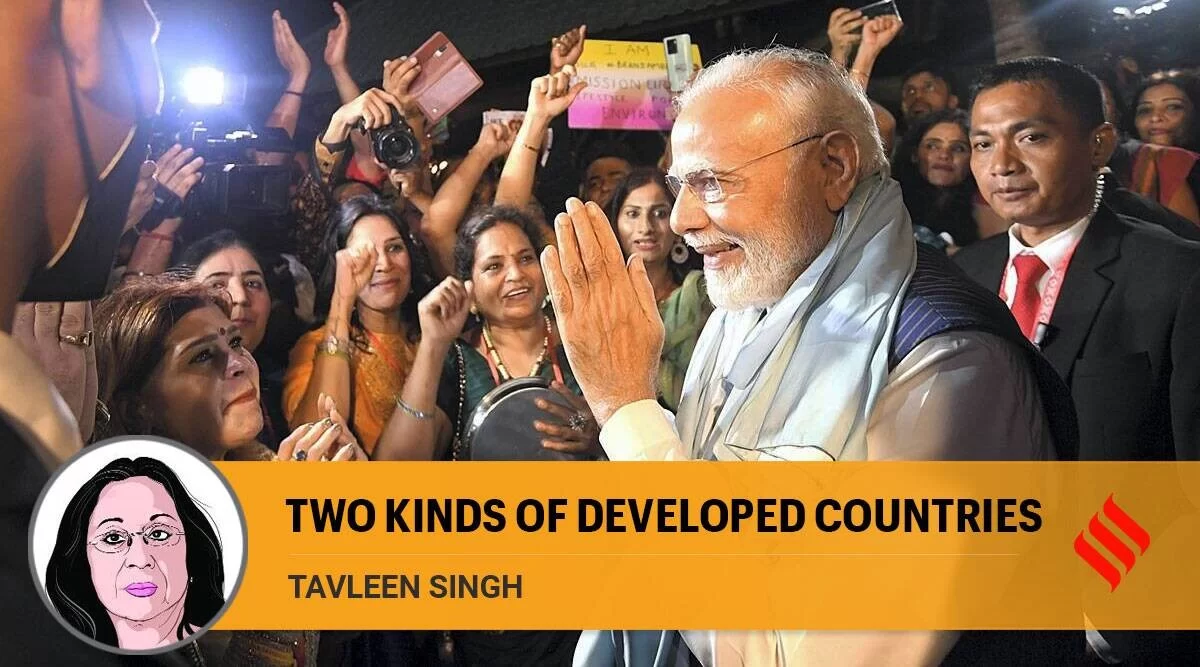PM Narendra Modi being greeted by Indian community after arriving in Bali to attend the G20 Summit, on Monday, Nov. 14, 2022. (PTI)
Tavleen Singh writes: Is PM Modi inspired by the model that has been created in China? Or is he inspired by democratic, western countries in which dissidence is applauded and not called treason?
Written by Tavleen Singh
Updated: November 20, 2022 8:44:39 am
“Tell me”, the Prime Minister asked in Bali last week, “what is the change you have noticed in India since 2014?” Modi, Modi, Modi came the response from the fawning group of non-resident Indians he was addressing. The Prime Minister smiled modestly before saying. “No. The change is not Modi. It is scale and speed. When we build a statue, we build the tallest in the world. When we build a cricket stadium, we build the biggest in the world. India no longer thinks small.” His audience responded with raucous cheers and applause.
There is nothing the Prime Minister seems to love more than addressing NRIs in foreign lands. So, wherever he goes, his team scouts around for suitable, non-dissident, Indians before whom he can make a speech. As someone who was in that vast audience in Madison Square Garden in 2014 when he made his first speech as India’s prime minister on foreign soil, I believe he likes NRIs better than resident Indians because they remain as devoted to him today as they were then. For them the Modi magic has not faded even if the promise of real ‘parivartan’ has not fully materialized.
It is true that highways are being built faster than before. True that more Indians have bank accounts. True that sanitation in rural India is hugely improved. True that we now have the tallest statue in the world and the largest cricket stadium and that it is named after Narendra Modi. A unique privilege for a living leader. But is India truly closer to becoming a developed country? Are most of India’s people truly better off than they were in 2014? Sadly, as any resident Indian knows well, not that much has changed. And the fact that rich Indians continue to flee in droves to better countries speaks for itself. A global Wealth Migration Review report estimates that 23,000 Indian millionaires have fled since 2014. Over 8,000 dollar millionaires are likely to flee before this year ends. And poorer Indians pay small fortunes to human traffickers to desperately find a developed country in which to live.
In the summer of 2014, when Modi first became prime minister, he used to promise when he addressed NRI gatherings that he would build an India from which nobody needed to flee as an economic refugee. This promise remains unfulfilled, and one reason is that we have not seen enough ‘scale and speed’ when it comes to creating new jobs or building a system of public education that would make finding a decent job easier. To this day, an average Indian child attending an average government school leaves without being able to read a story book, calculate difficult sums or learn the basic use of a computer.
Modi’s ‘new India’ remains a welfare state in which government largesse serves mostly to ‘alleviate’ poverty. Not eradicate it. But there is no question that India has changed since 2014 in ways that most NRIs remain blissfully unaware of. In Modi’s ‘new India’ the scale and speed with which dissidence is crushed is so remarkable that a political journalist said to me ominously the other day ‘political journalism is dead’. We in the media know this but saying this outright is a risky business.
The other change that has taken place with remarkable speed and on remarkable scale is the rise of an idea of Hindutva that makes non-Hindus, especially Muslims, feel that they are lesser Indians. Whenever these subjects are raised in the shrill, hysterical primetime debates that pass for political journalism these days, BJP spokesmen speak in one voice. They point out that if dissidence had been crushed there would be no primetime TV debates and is it not true that the Modi government’s largesse has been distributed without discrimination based on caste or creed.
True. But it is also true that if you happen to be a Muslim dissident you are more likely to end up rotting in a prison cell without any hope of bail. It is also true that if you happen to be a Muslim caught in a riot you are more likely to have your home demolished. Are these signs of India moving towards a bright and shining future or signs that we are moving backwards into a time of hatred and violence? Hatred and violence are usually the biggest obstacles to a country joining that privileged developed nations club.
These are not questions that Modi likes to be asked. And so far, he has chosen not to speak about these things perhaps because it is easier to forget that these changes have occurred since he became prime minister. Could that be the reason why the prime minister prefers to talk directly to Indians when he is in foreign countries and not when he is in our dear old Bharat Mata? At home the only time that he talks directly to ordinary Indians is when he addresses election rallies or when he tells them what he is thinking through Mann ki Baat.
This leads to a troubling question. What kind of ‘developed’ country does Modi hope India will one day become? Is he inspired by the model that has been created in China? Or is he inspired by democratic, western countries in which dissidence is applauded and not called treason? The ‘scale and speed’ of certain changes that have happened in India since 2014 are slightly scary.
© The Indian Express (P) Ltd
